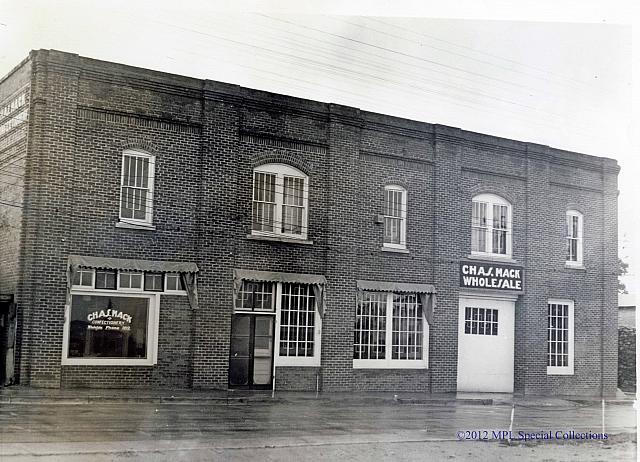
The Charles Mack Wholesale Building
Compiled by Andy Poore, Curator, Special Collections, Mooresville Public Library
The Charles Mack Wholesale Building was originally built in the 1890’s as a drying house for Barger Brother’s Construction. The building was located behind D.E. Turner’s Hardware Store. The building faces Center Avenue and is built at an angle on its’ lot. Facing the building, to the right of the front door is the original sliding door to the warehouse that allowed trucks to pick up a load of dried wood.
The boom crane and opening was located in the center of the second floor which the opening is now bricked up. The trucks would pull up to unload the lumber. The lumber was then hoisted up to the second floor where it was placed on racks. The room was lined with stoves that were used to control the heat during the drying process. There are three large chimneys on the roof of the building with the sliding doors in the ceiling of the upstairs room; these were used to control the heat and vent out smoke from the room during the drying process.
When you enter the building, the room to your left was the original sales/finance office. The windows are original, with the window on the far end the reception window for customers. Mr. Mack’s office was at the end of this long room. A counter ran from the reception window, down the side, in to the back area. When you enter, the rooms to the left, as well as the small room behind the counter were added later. Inside, on the left hand side of the warehouse was where the walk-in humidor was located. Cigarettes, cigars, and other tobacco products were kept in the humidor. This was the town’s first and only humidor.
Beside the humidor, you will find two cold rooms that were used to house candy products and other perishables. The candy room was lined with shelves where the boxes of candy were kept before being sold. Both rooms had large freezer doors and the temperature was regulated by a large refrigeration unit that was sold to Mr. Mack by the Mooresville Ice-cream Plant. The warehouse was lined with tall shelves that housed the boxes of items that were packed and sent out to various customers. The building still houses one of the oldest electric elevators in the town as well as the original staircase with the “slide” on the side where boxes were slid up and down the stairs. Mr. Mack operated his business until the late 1980’s until it closed.
In 1937, Charles Mack bought the building to move his wholesale business from Main Street into a larger building. The building was then purchased by John Mack, the son of Charles Mack, who gave the building back to the Town of Mooresville in 2006. The town then decided to use the building to house the Mooresville Museum. Walking back up the street to the corner and crossing the street toward the depot, we will continue our tour on Broad Street to the Central Hotel which we will discuss in next month’s local history corner.
